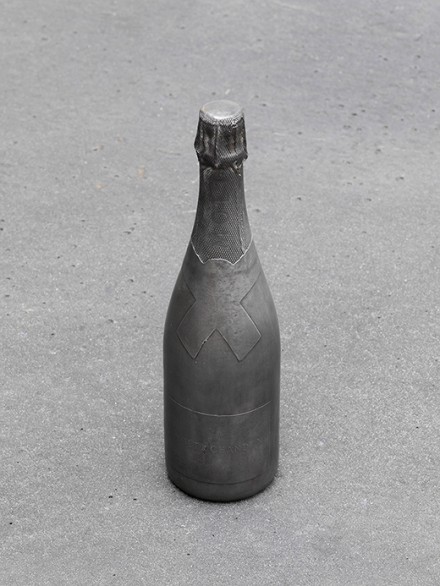
Alicja Kwade, Something absent, whose presence was expected (2015), via Johann König
A narrative surrealism infuses the work of Alicja Kwade. Works depict objects in the midst of transformation, moments of fusion, transposition and alteration of forms or materials that give the viewer the impression that time may in fact be standing still, if only for a moment. This sense of momentary pause is on view at the artist’s most recent solo exhibition at Johann König in Berlin, where the artist is presenting a body of new work under the title Something absent, whose presence was expected.

Alicja Kwade, Rellkt und Bedarf (2015), via Johann König
Kwade, the Polish-born, Berlin-based sculptor and assemblage artist, seems to draw particularly inspiration from the chemical, and often the alchemical methods of analysis gathered the world around her. Works appear to address sudden shifts in composition, or gradual movements away from an easily perceivable state. In her titular work, a large-scale marble sculpture, the artist places a series of chunks of material in a gradually diminishing pattern, moving from monolithic columns to a dusty powder. The illusory sensation of the work, as if the columns were fading into history and rising from its own ashes simultaneously, is commanding, to say the least.

Alicja Kwade, Heavy Light (2015), via Johann König
In another work, Heavy light, Kwade returns to her more cunning executions in formal, visual comedy, bending a neon light so that it hangs down from the fixtures running along the ceiling of the space, and puncturing the utilitarian architecture of the gallery with a momentary flash of surrealist humor.

Alicja Kwade, The heavy weight of lively light (2015), via Johann König
Elsewhere, the artist presents more graphic representations of the material obsessions that dominated early alchemical research during the middle ages and beyond. In one piece, The heavy weight of lively light, Kwade has cast a bottle of Möet and Chandon in solid lead, turning the status symbol into a far more durable, and far less ephemeral object. Alongside these, she presents vials containing purified capsules of the most prominent elements in the human body, a clinical reimagining the human as a series of basic materials that constitute its physical form, but returned to a state of pure possibility, not to mention a lack of causal agency.

Alicja Kwade, Something absent, whose presence was expected (Installation View), via Johann König
What makes Kwade’s show memorable are the subtle hints of potential energy, reactionary forces that have yet to emerge from the sculptures she presents here. Sustaining these moments through her compositions, the artist’s work feels balanced in a moment that offers much in terms of visual satisfaction, but little in terms of a final release.
Something absent, whose presence was expected is on view through April 18th.

Alicja Kwade, Something absent, whose presence was expected (Installation View), via Johann König

Alicja Kwade, Self-Portrait (2015), via Johann König
— D. Creahan
Read more:
Exhibition Site [Johann König]



